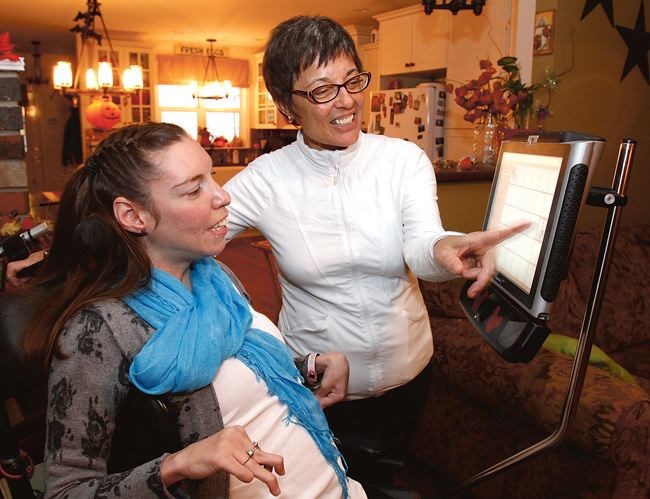Bree-Anna Robertson has a mischievous look that speaks volumes and with the help of the latest technology that offers her alternative communication, she also has a way to express that spirit that quite literally shines through her expressive eyes.
"Sorry, I didn't hear what you said, Bree, could you say it again?" asked speech language pathologist, Barbara Kayter.
"No!" Robertson said with a quick glance at the Dynavox VMax+Eyemax computer screen and a ready smile to assure her friend she's joking.
With a brief focus of her eyes on a word or symbol on the computer screen, Bree-Anna, who has cerebral palsy, can answer questions, make statements and play interactive games with friends and family.
It's the latest eye-gaze technology and the computer is attached by an angled steel arm to Robertson's scooter. It can easily be moved over to her bed when she wants to relax.
October is Augmentative and Alternative Communication (AAC) awareness month. When people can't speak due to a disability, different types of communication other than speech are used, including paper systems with keyboards, books with words or pictures or electronic equipment.
People in Prince George and elsewhere in the province can access equipment through Communication Assistance for Youth and Adults (CAYA).
"It's for those 19 years and up who have no functional speech, like people who have ALS, Parkinson's or cerebral palsy," said Kayter, the northern representative of CAYA. "We also help anyone coming from the school system, having used the school's equipment, and so we then step in to provide equipment to them. We provide continued service and assessments, recommendations, equipment, follow up training and it's a provincially funded program so there is no cost to the client."
Robertson, 28, is the first person to get into the local program as she left school. She has had some form of communication device since she was three years old.
"We were worried about how Bree was going to talk when she was done high school," said mom Terry. "You can't tell somebody after they have had a voice for 12 years 'sorry the communication device goes back to the school and you get nothing.'"
Robertson's previous communication device was also a computer and she had to use a stylus to touch the screen.
It was very taxing for her and it was a very long process as Robertson hadto switch screens to get to the vocabulary suitable for each conversation.
Because her hands are not very mobile, the eye-gaze system is much more accessible. She's had her current system, the VMax, for about four years.
Dad Gord programs information and maintains the complex computer system. As he sits beside his daughter, he is pushing buttons, adjusting the volume and going from the telephone conversation options screen to the regular conversation screen. So instead of Robertson saying 'this is Bree-Anna', during the interview, she then was able to say 'I am Bree-Anna'.
Both Terry and Gord are in tune with their daughter's thought and when she can't find the words on the screen to meet her communication needs, she will glance at one of her parents and with a small sound, speaks her wants and needs loud and clear.
It's a different story when they are out and about, as Robertson enjoys communicating with people by using her computer.
"This device allows Bree-Anna to be part of the community, to engage in conversation and express herself," said Gord.
For more information about CAYA's programs visit www.cayabc.org.



